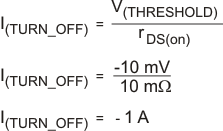ZHCSKC1D January 2007 – October 2019 TPS2412 , TPS2413
PRODUCTION DATA.
- 1 特性
- 2 应用
- 3 说明
- 4 修订历史记录
- 5 Device Comparison Table
- 6 Pin Configuration and Functions
- 7 Specifications
-
8 Detailed Description
- 8.1 Overview
- 8.2 Functional Block Diagram
- 8.3
Feature Description
- 8.3.1 Definitions
- 8.3.2 TPS2412 vs TPS2413 – MOSFET Control Methods
- 8.3.3 N+1 Power Supply – Typical Connection
- 8.3.4 Input ORing – Typical Connection
- 8.3.5 System Design and Behavior With Transients
- 8.3.6 TPS2412 Regulation-Loop Stability
- 8.3.7 MOSFET Selection and R(RSET)
- 8.3.8 Gate Drive, Charge Pump and C(BYP)
- 8.4 Device Functional Modes
- 9 Application and Implementation
- 10Power Supply Recommendations
- 11Layout
- 12器件和文档支持
- 13机械、封装和可订购信息
请参考 PDF 数据表获取器件具体的封装图。
机械数据 (封装 | 引脚)
- D|8
- PW|8
散热焊盘机械数据 (封装 | 引脚)
8.3.7 MOSFET Selection and R(RSET)
MOSFET selection criteria include voltage rating, voltage drop, power dissipation, size, and cost. The voltage rating consists of both the ability to withstand the rail voltage with expected transients, and the gate breakdown voltage. The MOSFET gate rating should be the minimum of 12 V, or the controlled rail voltage. Typically this requires a ±20-V GATE voltage rating.
While rDS(on) is often chosen with the power dissipation, voltage drop, size and cost in mind, there are several other factors to be concerned with in ORing applications. When using the TPS2412, the minimum voltage across the device is 10 mV. A device that would have a lower voltage drop at full-load would be overspecified. When using a TPS2413 or TPS2412 with RSET programmed to a negative voltage, the permitted static reverse current is equal to the turnoff threshold divided by the rDS(on). While this current may actually be desirable in some systems, the amount may be controlled by selection of rDS(on) and RSET. The practical range of rDS(on) for a single MOSFET runs from the low milliohms to 40 mΩ for a single MOSFET.
MOSFETs may be paralleled for lower voltage drop (power loss) at high current. For TPS2412 operation, one should plan for only one of the MOSFETs to carry current until the 10 mV regulation point is exceeded and the loop forces GATE fully ON. TPS2413 operation does not rely on linear range operation, so the MOSFETs are all ON or OFF together except for short transitional times. Beyond the control issues, current sharing depends on the resistance match including both the rDS(on) and the connection resistance.
The TPS2412 may be used without a resistor on RSET. In this case, the turnoff V(AC) threshold is about 3 mV. The TPS2413 may only be operated without an RSET programming resistor if the loading provides a higher V(AC). A larger negative turnoff threshold reduces sensitivity to false tripping due to noise on the bus, but permits larger static reverse current. Installing a resistor from RSET to ground creates a negative shift in the fast turnoff threshold per Equation 2.

To obtain a –10 mV fast turnoff ( V(A) is less than V(C) by 10 mV ), R(RSET) = (–470.02/ ( –0.01–0.00314) ) ≈ 35,700Ω. If a 10 mΩ rDS(on) MOSFET was used, the reverse turnoff current would be calculated using Equation 3.

The sign indicates that the current is reverse, or flows from the MOSFET drain to source ( C to A ).
The turnoff speed of a MOSFET is influenced by the effective gate-source and gate-drain capacitance CISS). Because these capacitances vary a great deal between different vendor parts and technologies, they should be considered when selecting a MOSFET where the fastest turnoff is desired.